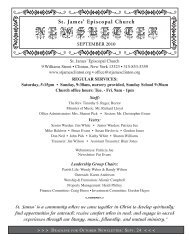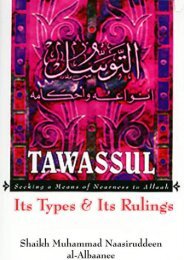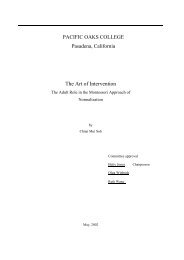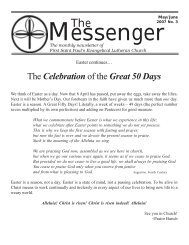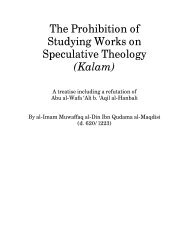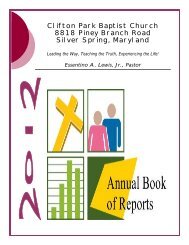Scripture and God in Christianity
Scripture and God in Christianity
Scripture and God in Christianity
You also want an ePaper? Increase the reach of your titles
YUMPU automatically turns print PDFs into web optimized ePapers that Google loves.
Persons, <strong>and</strong> is not three separate th<strong>in</strong>gs." 635 He further argues that "The Father is <strong>God</strong> <strong>and</strong> the<br />
Son is <strong>God</strong>; <strong>and</strong> yet by the same affirmation <strong>God</strong> is one, because no dist<strong>in</strong>ction of nature or of<br />
operation is to be observed <strong>in</strong> the <strong>God</strong>head.... s<strong>in</strong>ce the div<strong>in</strong>e, s<strong>in</strong>gle, <strong>and</strong> unchang<strong>in</strong>g nature eschews<br />
all diversity of essence, <strong>in</strong> order to guard its unity, it admits of itself no plural significance."<br />
636<br />
He dist<strong>in</strong>guishes between Persons on the basis of causality, "the only way by which we dist<strong>in</strong>guish<br />
one Person from the other, by believ<strong>in</strong>g, that is, that one is the cause <strong>and</strong> the other depends<br />
on the cause. Aga<strong>in</strong>, we recognize another dist<strong>in</strong>ction with rearguard to that which depends on<br />
the cause. There is that which depends on the first cause <strong>and</strong> that which is derived from what<br />
immediately depends on the first cause. Thus the attribute of be<strong>in</strong>g only-begotten without doubt<br />
rema<strong>in</strong>s with the Son, <strong>and</strong> we do not question that the Spirit is derived from the Father." 637 He<br />
concludes argu<strong>in</strong>g that "The pr<strong>in</strong>ciple of causality dist<strong>in</strong>guishes, then, the Persons of the holy<br />
Tr<strong>in</strong>ity. It affirms that the one is uncaused, while the other depends on the cause. But the div<strong>in</strong>e<br />
nature is <strong>in</strong> every way understood to be without dist<strong>in</strong>ction or difference. For this reason we<br />
rightly say there is one <strong>God</strong>head <strong>and</strong> one <strong>God</strong>, <strong>and</strong> express all the other attributes that befit the<br />
div<strong>in</strong>e <strong>in</strong> the s<strong>in</strong>gular." 638 How the uncaused first cause <strong>and</strong> the caused or derived from the Father<br />
can be the same, equal <strong>in</strong> all properties <strong>and</strong> respects is a valid question not satisfactorily answered<br />
by any of the Cappadocians.<br />
This Cappadocian analogy is one of the two chief types of analogy that has been used throughout<br />
the course of Christian history <strong>in</strong> reference to the Tr<strong>in</strong>ity. The Cappadocians beg<strong>in</strong> with a consideration<br />
of three persons, as we have just seen, while August<strong>in</strong>ian analogy emphasizes coequal<br />
Tr<strong>in</strong>ity by dist<strong>in</strong>guish<strong>in</strong>g the persons <strong>in</strong> terms of <strong>in</strong>ternal relations with<strong>in</strong> a person (e.g., memory,<br />
will, <strong>and</strong> <strong>in</strong>telligence or love, the lover (amans) <strong>and</strong> the object loved (quod amatur). 639 Both of<br />
them are not satisfactory <strong>and</strong> have several flaws. The former, for <strong>in</strong>stance, could lead to tritheism<br />
while the latter could lead to Sabellianism or Unitarianism. Francis Young rightly observes about<br />
Gregory of Nyssa's analogy that "No matter how much he protests their common eternity, common<br />
activity <strong>and</strong> common will, it is difficult to call a theology based on such a def<strong>in</strong>ition of their<br />
common nature, monotheistic." 640 Others like Harnack, F. Loofs, F. W. Green 641 have observed<br />
that this Cappadocian position was really a k<strong>in</strong>d of Homoean view, or to use Harnack's words, "<br />
the community of substance <strong>in</strong> the sense of likeness (or equality) of substance, not <strong>in</strong> that of unity<br />
of substance." 642 To E. R. Hardy this observation is mislead<strong>in</strong>g <strong>and</strong> "far from fair". He argues<br />
that "ousia is not to be regarded merely as a universal, <strong>and</strong> hypostasis as a particular <strong>in</strong>stance of<br />
it. That would surely lead to tritheism. The Cappadocian idea is far more subtle. The nature of<br />
the <strong>God</strong>head more nearly corresponds <strong>in</strong> their thought to Aristotle's idea of a particular, concrete<br />
existence (proto ousia), not to the deutera ousia which members of a species have <strong>in</strong> common.<br />
The ousia <strong>in</strong> the <strong>God</strong>head is identical <strong>in</strong> each Person: the common humanity <strong>in</strong> men is only generic."<br />
643<br />
Hardy's explanation is attractive but seems a little forced <strong>and</strong> artificial. The Cappadocians seem<br />
to have used the terms <strong>in</strong> their generic forms without much specifications. It will be too much to<br />
say that the Cappadocian Fathers <strong>in</strong>tended tritheism but it seems quite fair to observe that their<br />
dist<strong>in</strong>ction between three Persons of the Tr<strong>in</strong>ity <strong>and</strong> their usage of the analogy of Peter, James,<br />
<strong>and</strong> John could easily lead to tritheism as it was observed even dur<strong>in</strong>g their own life time. Our<br />
79





